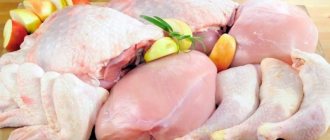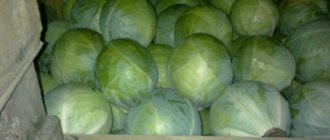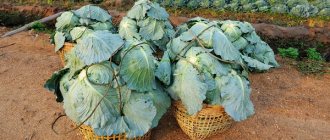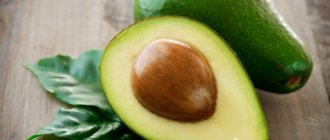Cauliflower is a healthy vegetable that can be used in preparing various dishes. In order for a vegetable to retain its properties, it must be stored correctly.
In a city apartment, the optimal place for this is the refrigerator.
How to properly store cauliflower in the refrigerator so that it does not darken, what is the maximum shelf life of the vegetable at home, read the article.
Preparing for storage at home
Properly collected cabbage heads are suitable for storage . They are harvested during the growing period, preventing the crop from becoming overripe. The heads should weigh between 0.3-1.2 kg.
If the fork is crumbly, yellow in color, does not hold its shape and is limp, it is not suitable for long-term storage. A vegetable that has outgrown the harvest time loses a significant part of its nutrients.
Cabbage is harvested in dry weather.
The cut inflorescences should be immediately transferred to the shade so that they do not begin to wither. Procedure for preparing cabbage:
- Remove dense stalks.
- Remove outer yellowed leaves.
- If there are sprouted leaves, they are removed.
- Rinse.
- Dry.
Vegetable inflorescences are demanding in terms of maintenance conditions. The duration of lying down directly depends on their compliance.
Storage methods
There are several simple ways to preserve cauliflower for the winter. Each of them differs in special conditions for preparing the vegetable and the period during which it does not spoil.
In the freezer
Freezing is one of the most popular and long-lasting ways to preserve cauliflower. The technology requires several mandatory steps:
- the vegetable is washed under running water to remove dirt and insects;
- remove leaves, disassemble into inflorescences;
- blanch for 2 minutes in salted water;
- cool the inflorescences, blot with paper towels;
- place in the freezer in one layer until frozen;
- transfer to a container or plastic bag.
To prevent frozen cauliflower from darkening, add lemon juice when cooking. It helps maintain the original color of the pulp.
In a refrigerator
Cauliflower is stored on a special vegetable shelf. The heads of cabbage are pre-washed, stripped of leaves and packaged individually in paper or cling film. Every few days it is necessary to inspect the vegetable, remove spoiled inflorescences and change the packaging. During storage, the product should be protected from sudden changes in humidity and temperature.
In the refrigerator, the heads of cabbage do not disappear for a maximum of 3 months. You can extend the period using saline solution. To do this, individual inflorescences are placed in a glass jar and filled with brine. To do this, dissolve 30 g of salt in 1 liter of water.
In the cellar
A dark room is suitable for storage if the temperature and humidity are at the required level. Heads of cabbage are placed in 2 ways: suspended from the ceiling or rooted in wet sand. In the first case, the following technology is followed:
- cauliflower is harvested before frost sets in;
- select ripe, strong specimens without signs of diseases and pests;
- remove outer dry leaves;
- tie each stalk with twine;
- hang with inflorescences down;
- The heads of cabbage are placed so that they do not touch each other, this provokes the spread of rot.
You can place cauliflower on wooden shelves. In this case, the vegetable should be turned over every week for uniform ventilation.
If there are unripe heads of cabbage left in the garden, they can be moved to the cellar along with a lump of earth and continued to be grown at a temperature of 0-4 °C. Wet sand is used as a substrate. The room is often ventilated.
On the balcony
Preserving a vegetable harvest on the balcony is more difficult than in a cellar or refrigerator due to unpredictable weather conditions. The heads of cabbage are stored in paper, separately from each other, until night frosts begin (when the temperature on the balcony drops below 0°C, you will have to look for another place for storage). The vegetable is protected from sunlight and insects, regularly inspected and spoiled inflorescences are removed.
We recommend reading
Benefits of cauliflower for human health
The benefits and harms of sauerkraut for human health
What varieties of cabbage are suitable for pickling, pickling and storing for the winter?
Features and methods of storing white cabbage
How to preserve it so that it does not darken or spoil?
A vegetable that requires storage conditions must be carefully selected and prepared. After that:
- The cabbage is packaged - each head is placed separately in a plastic bag or wrapped in cling film.
- Place in a compartment designed for storing vegetables.
If the zone with the lowest possible temperature is inaccessible (for example, occupied by other vegetables), the cabbage will be preserved less well.
It is also undesirable to allow sudden changes in temperature , since during prolonged storage this can lead to the following consequences:
- acquisition of a dark shade by heads of cabbage;
- a change in the taste of a vegetable due to the appearance of unusual bitterness.
Ultimately, this leads to the vegetable becoming unfit for consumption. It will be impossible to eliminate the unpleasant signs that appear.
Preventing cabbage heads from touching each other increases the shelf life of the vegetable.
In addition to the usual storage method, you can put the vegetable disassembled into inflorescences into jars and sprinkle it with salt . The top of the container is covered with parchment.
You will find a lot of useful information about ways to store cauliflower here.
Storage conditions and preparation of cauliflower
The root crop feels great at a temperature of 0 degrees and a humidity of no more than 95%. If the temperature drops, the inflorescences will freeze slightly. And when the temperature rises, germination occurs. The room, whether it is a cellar or a basement, must be ventilated, dark and cool. There should be no dampness in it. Only late varieties of cabbage are subject to long-term storage.
In this case, the freshest specimens are selected, not overripe, without defects. Ideally, if the cultivation was carried out independently, this way you can control the timing of the harvest. But be that as it may, before storing you need to dry the vegetables a little and only then proceed with further actions, which will depend on the place where the cauliflower is stored.
How long vegetables can be stored
In the refrigerator, storage conditions will differ from the cellar, which is optimal for keeping vegetables.
Without losing its properties, cabbage can be kept in it for no more than 2 weeks, a maximum of 3-4 with proper packaging and maintaining the desired temperature. Unpacked - lies less than wrapped in film.
Significantly extends the shelf life of freezing. At low temperatures, cabbage can be stored in the freezer for up to six months to a year.
Which varieties are best for storage?
Early varieties quickly reach technical ripeness, but are characterized by a high moisture content and loose pulp. These indicators prevent long-term storage of vegetables. The purpose of early ripening cabbage is to eat fresh.
For long-term storage, late varieties of vegetables are mainly intended, the ripening period of which is 3-4 months. Mid-season varieties are used for freezing. The most popular varieties and hybrids for winter storage include:
- Amerigo F1;
- White Beauty;
- Cortez F1;
- Autumn Giant;
- Flora Blanca.
Seed producers indicate on the packaging information about the purpose of the vegetable crop and ripening time. When choosing a variety or hybrid, they are guided by the recommendations of breeders.
How to freeze correctly?
Cauliflower can be frozen. For this purpose, you should select strong, dense heads of cabbage and carry out the following activities:
Remove leaves.- Wash.
- Disassemble into inflorescences.
- Boil for 3-5 minutes.
- Place the inflorescences in a colander to drain.
- Place on paper towels to remove excess water.
- Place in separate containers or special freezer bags.
- Place the container with the inflorescences in the freezer. Until the freezing process is completed, the containers must be shaken periodically to prevent the inflorescences from sticking together.
Another option is freezing fresh vegetables. The technology for carrying out the work is similar to the previous method, excluding the cooking process.
Disadvantages of this approach:
- the likelihood of spoilage of cabbage increases;
- After defrosting and cooking the vegetable, its taste will differ from cabbage that was boiled before freezing.
Vegetables can be stored in the freezer in various forms:
- whole or sliced;
- cooked or fresh.
Once defrosted, cabbage cannot be re-frozen. This article will tell you how to freeze cauliflower for the winter.
3 ways to freeze cauliflower are presented in the video:
How else can you save vegetables for the winter?
Another option for obtaining fresh vegetables for winter is growing. This method can be used if the forks have not yet matured to the required size by the time of harvest. Rearing is carried out as follows:
- a few days before harvesting, the cabbage must be watered generously;
- Dig up the heads of cabbage with roots and an adjacent lump of earth;
- in the basement, prepare earthen beds by filling the boxes with soil, and plant plants tightly in them, filling them with soil to the level of the lower leaves;
- The soil should be watered as needed.
The room temperature should be maintained at 1-2°C and frequent ventilation should be provided to prevent high humidity levels. During the growing period, which can last up to 6 months, the forks reach the required size and retain their taste.
The beneficial substances contained in cauliflower can be obtained not only immediately after harvest, but also after a long time. Subject to temperature and light conditions, as well as acceptable humidity levels, the vegetable can be stored in the refrigerator, cellar or basement.
Alternative Methods
If there is no cellar and space in the refrigerator, the vegetable is stored dried or canned in a dark, dry place in the apartment.
Drying
The heads of cabbage are washed, separated into inflorescences and laid out on a baking sheet in a thin layer. Preheat the oven to 60 degrees and place a baking sheet there for 2 hours. Periodically you need to check the condition of the inflorescences. When they become yellowish but elastic, remove the baking sheet. The finished drying is placed in clean glass jars, which are covered with parchment. Dried cauliflower is stored in the pantry, in the kitchen cabinet.
Canning
To prepare canning for the winter, roots and leaves are separated from the heads of cabbage. Cabbage is covered with onions and walnuts, tomatoes, peppers, carrots, beets, and garlic. To prepare the marinade, pour 9% vinegar into boiling salted water. For half a liter of water - 1 tablespoon of salt and 2 tablespoons of vinegar. Cabbage is mixed with chopped additional ingredients and distributed into sterilized jars. Then pour in the marinade and boil for 10 minutes.
See also
How and how long can you store peeled potatoes at home?
Canned food is prepared without sterilization. The jars are filled with brine - boiling water with 2 tablespoons of salt and sugar dissolved. Then add a teaspoon of vinegar and roll up. For taste, bay leaf, coriander, black pepper, and cloves are added to canned cabbage. Preservation is stored at home, in a dark place, at room temperature.
Factors affecting shelf life
The duration of preservation of the nutritional properties of cauliflower depends on the following basic conditions:
- Temperature . When stored fresh, it should be between 0°C and +6°C.
- Humidity . The optimal value for fresh fruits is 85-95%.
- Storage method . When fresh, the heads of cabbage can be stored for no more than 2 months, when frozen – up to 1 year.
- Quality of heads of cabbage . The fruits must be healthy, without damage or other defects. If there is damage or pest infestation, such heads of cabbage are not suitable for long-term storage; they must be consumed immediately.
- Variety . Late varieties last the longest. The most popular are Amerigo, Cortes, Sochi, Asterix, Adler winter and Adler spring.
How to tell if cauliflower has gone bad
You can determine if a vegetable is spoiled by the following signs:
- The appearance of black spots.
- Fungal plaque.
- Covered with mucus.
- Unpleasant putrid odor.
- Too soft, squeezable consistency.
- Some areas of the inflorescences became wet.
Spoiled cauliflower should not be eaten . It develops microorganisms that can lead to serious food poisoning and even diseases such as botulism.
Causes of cabbage spoilage
Some housewives are perplexed why cabbage can darken, turn black, turn blue or green in the freezer or refrigerator. Most often, the reason is that the rules were not followed at the stage of preparing the product for storage. This may also be due to the fact that the freezer is “weak” and does not maintain the desired temperature.
If the vegetable begins to turn black, this indicates that rotting processes have begun. It can no longer be eaten, even if the damaged areas are cut off, since the microflora penetrates deep inside and infects it entirely. Cabbage can darken in the freezer if it is sent there damp and not thoroughly dried.
If the temperature fluctuates greatly, the cabbage quickly turns gray or black, and its taste also suffers.
Storing cauliflower is more difficult than white cabbage, but by adhering to the recommendations described above, you will be able to successfully extend its life and enjoy the healthy vegetable throughout the winter. In order not to be disappointed when you see a spoiled product in the refrigerator, freezer or basement, it is important to properly prepare the product for storage and regularly monitor its condition.
Video: how to properly freeze and store cauliflower
Watch this video on YouTube
Do you want to understand better than others?
- How to properly store sauerkraut - Sauerkraut is a product that contains a large number of useful macro- and microelements and vitamins. It is easy to prepare and is one of the favorite dishes in…
- Freezing grapes: preparation and storage - The article provides recommendations for freezing grapes for the winter and describes a method for winter storage of grape cuttings in the refrigerator. Why freeze grapes in winter...
- The most popular ways to freeze chanterelles for the winter - Chanterelles have more pronounced taste characteristics when compared with champignons and oyster mushrooms. However, their significant drawback is the limited period...
- How much and how can you store soup in the refrigerator - Soup is a balanced meal that allows you to quickly fill up. Thanks to the many recipes, you can prepare different soups every day, but often you don’t have enough time...
- How to properly freeze fresh cherries for the winter - Cherries are rarely frozen; most likely, many housewives simply do not know that this berry best retains its beneficial properties in the freezer. This is the optimal…
Harvest correctly!
Cauliflower is harvested from June to October, because different varieties differ in the length of the growing season. Moreover, due to the characteristics of ripening, late-ripening is stored better and longer. Vegetables that ripen in early and mid-summer have a low shelf life.
Harvest Features:
- cabbage inflorescences are removed from the beds only in warm, dry weather;
- They begin to harvest cabbage while it is still growing, when the heads reach a diameter of 8-12 cm and gain a weight of 300-1200 g. Overripe heads of cabbage (faded yellow, crumbly inflorescence) are not suitable for long-term storage;
- cut off the head of cabbage with a sharp wide knife https://bestblades.ru/, without touching the lower leaves;
- Vegetables removed from the garden are immediately transferred to a dark place. In the light, the vegetable quickly turns yellow and withers, which significantly reduces its shelf life.
Important! The shelf life of vegetables is affected by the application of certain types of fertilizers during the growing process.
For this crop, restrictions are placed on nitrogen fertilizers, since keeping cauliflower fresh for the winter will be much more difficult in this case.
How to store cauliflower in the cellar: different ways
Experienced gardeners say that cauliflower lasts a long time if you dig it, along with its roots, into boxes with sand or soil taken from the garden. Residents of northern regions, where crops do not have time to ripen before the onset of cold weather, often use this method. The fact is that the growing season will continue for some time. Even unripe inflorescences will increase in size due to the nutrients accumulated by the leaves.
Unripe cauliflower
This storage method is not suitable if there are too many bushes.
Reference. You can also dig in plants cut off with part of the shoot, and not just those that have roots.
In a clay mash
This storage method is not so popular, but some vegetable growers use it. It is suitable for those whose harvest is not too large. Each inflorescence is dipped into a solution prepared from clay diluted with two parts water. Next, the vegetables are hung in the fresh air to dry. When the clay on the surface hardens, the forks are placed in boxes or on shelves.
Reference. Getting rid of the protective shell is simple - you just need to hit it. The clay layer will immediately crumble, leaving no mark on the vegetable.
In wooden boxes
Cauliflower is stored in wooden boxes. To prevent the heads from touching each other, partitions made of plywood or very thick cardboard are laid between them. The inflorescences are laid loosely, trying not to damage them.
Attention! If the air in the basement is dry, the boxes are covered with polyethylene to maintain a normal level of humidity inside.
In limbo
It is possible to preserve cauliflower heads for up to 6 months if you hang them by the stems in the cellar . The leaves are not cleaned; they serve as an additional barrier that protects against wilting and microbes. It is important to maintain a small distance between the fruits for better air circulation.
In paper
Cauliflower will last for several months in a paper wrapper. Before storing, the inflorescences must be completely dry. Each fruit is wrapped in several layers of paper and carefully placed in boxes.
Attention! Newspapers cannot be used, as printing ink contains substances hazardous to health.
Gardeners recommend inspecting the crops in the basement every week. If you find wet marks on the paper, you need to make sure that the head is not rotten. It is advisable to periodically replace the old paper casing with a new one.
How to prepare for long-term storage
Which heads of cabbage can be stored:
- with a clean surface of uniform color;
- dense, with whole inflorescences;
- juicy.
Spots, yellowing, and lethargy are signs of fungus and wilt. In storage they will spread to healthy vegetables. Fading inflorescences will not gain juice and will become like cotton wool in dishes.
What to do with cabbage after purchasing or harvesting:
- divide the heads of cabbage into parts;
- trim roots, leaves;
- Rinse;
- dry thoroughly.
In this form, the ripe heads are ready to be placed in the refrigerator, dried, or preserved. When collecting unripe heads of cabbage, they are dug up with roots and a lump of earth, planted in boxes or placed in open glass jars, and placed in the cellar. Ripening vegetable crops need to be watered regularly.
In the freezer
Cauliflower lasts the longest in the freezer. Freezing whole heads at home is not convenient. Therefore, disassemble them into inflorescences of 4-5 cm. You can freeze the vegetable fresh or lightly boiled; to do this, dip the pieces in boiling water for 3-4 minutes, cool and dry. Seat the cauliflower in plastic bags or special food containers.
Choose containers that can be used in the freezer. This is indicated by a special “snowflake” icon at the bottom of the container.
It is optimal to use the fast freezing mode. With this storage method, the vegetable retains most of its beneficial properties. When frozen, cauliflower has a shelf life of up to 12 months.
Storage space
Cauliflower is stored in different ways. Optimal conditions: temperature - 0...+5°C, humidity - 90-95%. When the recommended temperature drops, the vegetable will freeze; when it rises, it will begin to germinate. The best places for storage are the cellar, refrigerator, balcony.
In a refrigerator
To place the forks in the refrigerator, prepare them as follows:
- Wash thoroughly and remove leaves. Divide into inflorescences and lay out on a clean towel to dry.
- The dried inflorescences are wrapped in two layers of cling film, thus limiting the access of air.
- Place in the vegetable compartment.
In this form, the vegetable can be stored for up to 16-18 days. The cling film is changed periodically, as condensation forms on it inside. This leads to rotting of the product.
On the balcony
If there is no cellar, the harvest is stored on the balcony. The heads are placed in wooden or plastic boxes filled with sand and tightly covered with opaque film. This is necessary to maintain humidity inside the container.
Forks are also placed on the shelves of lockable balcony cabinets. The inflorescences are first wrapped in cling film. Every 5-6 days the vegetables are inspected, the film with condensate is changed.
Attention! When the air temperature drops below 0°C, drawers and shelves should be covered with old blankets.
The best conditions are created on a glassed-in loggia, where the temperature does not drop to sub-zero levels.
In the basement or cellar
In cellar and basement conditions, cabbage does not lose its beneficial properties for 3-4 months. Before planting the crop, the walls, ceiling and floor are carefully treated with antiseptic agents. The room is provided with air circulation through two ventilation holes: fresh air enters into the first, and fumes from stored vegetables are removed through the other. They create the necessary microclimate with air temperature 0...+5°C and humidity 90-95%.
Pre-washed and dried heads without stalks and with 3-4 outer leaves are placed in a wooden or plastic container, laid out on the floor, shelves, and hung from the ceiling. Vegetables are periodically inspected to monitor the onset of rotting and disease. Spoiled forks are removed so that putrefactive processes do not spread to neighboring vegetables.
At what temperature should cauliflower be stored?
The vegetable loves low temperatures. Cauliflower stores well at zero degrees. But the drop threatens freezing. When increasing from +5, the taste deteriorates. In the warmth, the buds may open. Storage sometimes causes many difficulties.
The ideal place is a deep cellar, but with ventilation. It is often difficult to organize such conditions. We have to come up with something. Freezing, drying, canning helps. It is allowed to place cauliflower in the refrigerator. Storage on the balcony or loggia is practiced. Let's consider these methods in detail.
Common Mistakes
Colored heads of cabbage spoil quickly if:
- close the boxes with a tight, airtight lid;
- grow under artificial light;
- leave for a long time without inspection for damage;
- transfer from cold to warm and back;
- tie and hang in bunches;
- freeze, put undried inflorescences in the refrigerator.
Don’t be greedy and try to save limp heads of cabbage, and also pack them tightly into deep boxes to save space in the cellar or on the balcony. Plants will begin to actively release ethylene gas, which accelerates wilting and the crop will die.











